Snakes are also called serpents. The word ”serpents” originates in Latin with serpens, which refers to a legless crawling thing – a snake. Colorful snakes are not always venomous, as popularly believed.
Snakes are slithering, legless reptiles that inhabit every part of the planet except Antarctica. There are nearly 4,000 snakes to choose from, but we’ve narrowed down the coolest-looking snakes to this list of our top eleven picks.
11. Ringneck Snake
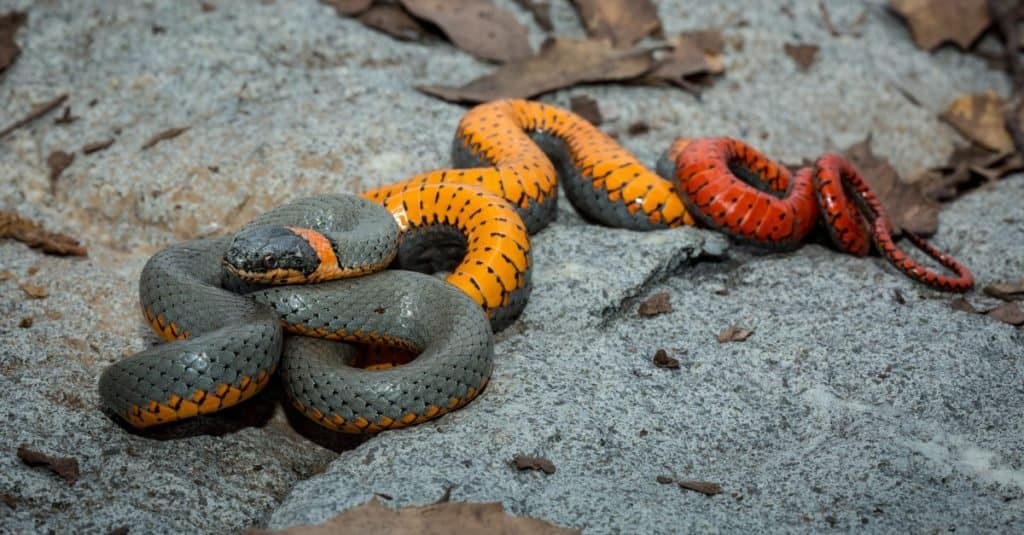
Ringneck snakes are commonly kept as pets.
©Michael K. McDermott/Shutterstock.com
Starting off our list is the ringneck snake that looks like it’s wearing an orange necklace. Its average size of 10 to 15 inches also makes it small enough to be cute. Being cute and accessorized really makes this snake cool-looking.
Although they are common, these snakes are nocturnal and secretive, so they’re hard to spot in the wild. They tend to dine on earthworms and slugs, though they’ll also consume small frogs and lizards. Ringneck snakes are also known to eat juvenile snakes.
Ringneck snakes are found in southern Canada, Mexico, and the United States. They’re kept as pets and eat a diet mainly of insects and earthworms. There are a few different kinds of ringneck snakes, but all have characteristic band around their neck.
10. Palmetto Corn Snake
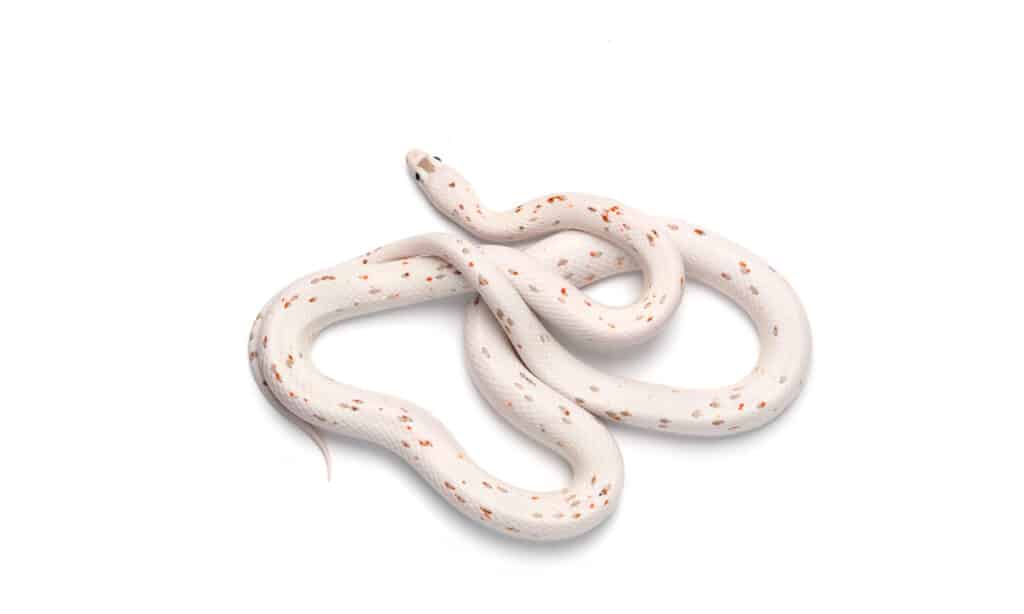
Palmetto corn snakes are off-white with speckles.
©PetlinDmitry/Shutterstock.com
[image: a palmetto corn snake. Caption – Palmetto corn snakes are off-white with speckles.]
This snake is a color morph of typical corn snakes from the Pantherophis guttatus species. It has a creamy-white body with brown freckles that make it look like pecan praline ice cream from a distance, though its speckles contain some blotchy red as well. Its look, like a classic dessert, is really cool, so we’re putting this snake on our coolest looking snakes in the world list.
No one knows exactly why corn snakes are called corn snakes. It may be because they hang out around corn stockpiles, and it may be because their colored scales can look like corn. These snakes are often bred in captivity, but they can also be found in the wild. Their coloration is caused by a recessive gene.
Palmetto corn snakes make great first-time snakes for ownership, although they’re a 15 to 20-year commitment. They constrict their prey instead of biting it, so they’re not prone to biting. They also possess little venom, so even if they manage to chomp down on a human, it’s not very dangerous.
The palmetto corn snake is named because it was discovered in South Carolina, which is the palmetto state. The palmetto is a small shaggy palm tree-like plant and has little to do with the palmetto corn snake.
9. Barbados Threadsnake

Barbados thread snakes are tiny and rare.
©somyot pattana/Shutterstock.com
These snakes are really cool-looking because they’re so tiny. The largest of the Barbados thread snakes is only 4 inches long, and they’re blind burrowers.
The Barbados thread snake was originally discovered in 2008, but right after its discovery, museums uncovered misclassified specimens dating back to the late 1800s.
There’s a similar invasive yet common species, a lot like the Barbados thread snake that competes for the depleted territory available in Barbados. That snake is the flowerpot blindsnake, and while it’s similar to the Barbados thread snake, it is distinctly different. Humans are ultimately the biggest threat to the rare Barbados thread snake.
8. Scaleless Corn Snake
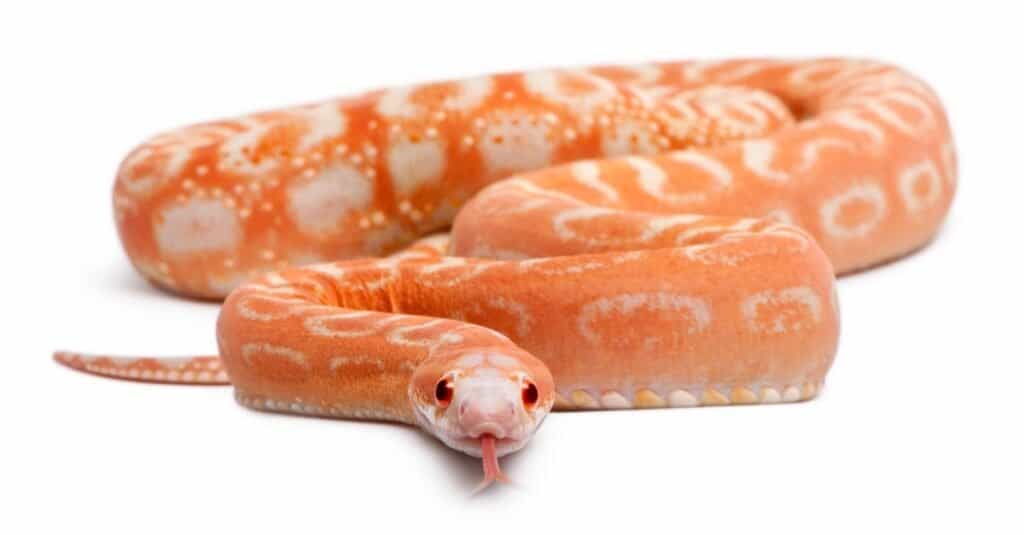
The scaleless corn snake has some scales.
©iStock.com/GlobalP
The scaleless corn snake isn’t completely scaleless. It has some scales on its belly and patterns on its body, but the fact that even some parts of this snake are scaleless makes it look super cool.
This critter has bulging eyes that are, in fact, not any larger in proportion to its body than other snakes. Since the eyes lack scales, they look humongous.
The scaleless corn snake almost always exists because it is bred in captivity and not really in the wild. It is a hybridization of corn snakes and rat snakes. It exists in the wild but is super hard to find.
7. San Francisco Garter Snake
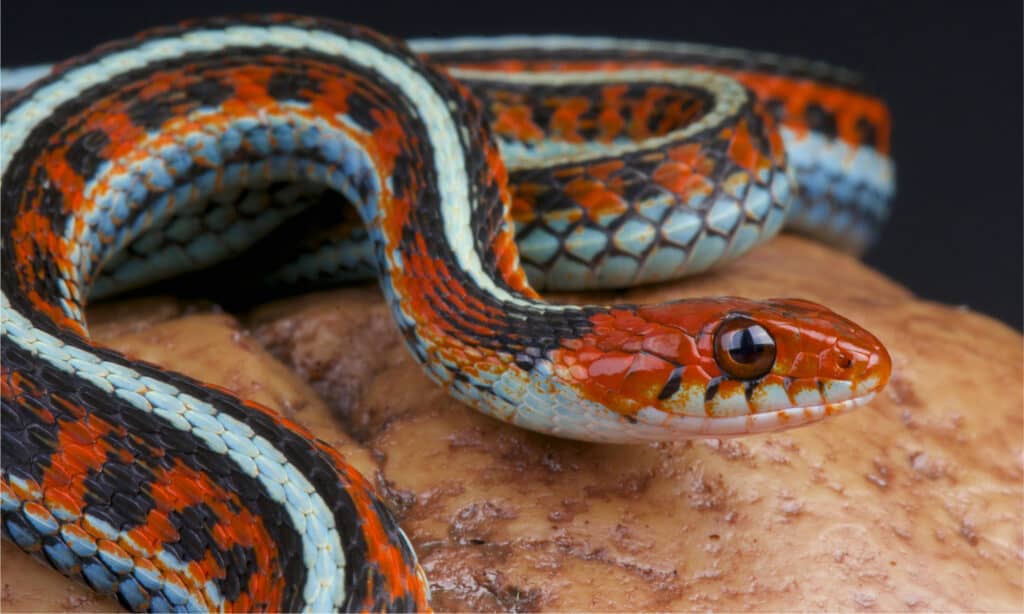
San Francisco garter snakes
are endangered because of human development.
©reptiles4all/Shutterstock.com
This San Francisco garter snake has made it onto our coolest-looking list because of its striking appearance. It’s a subspecies of the common garter snake, is found in Northern California, and is endangered. It has a colorful striped and dotted pattern consisting of orange, red, black, and turquoise.
These snakes are harmless even though they have some venom in their saliva. They don’t have fangs, so they’re really not to be feared. These snakes are found near water, and they lure their prey in with their black-tipped red tongue. They can grow up to four and a half feet in length.
San Francisco garter snakes were declared an endangered species in 1967, and their numbers continue to decline due to development and the pet trade. A lot of these snakes are stolen from their habitat for collectors, and it’s easy to see why.
They are really cool looking. They only consist of a few thousand wild individuals, and it’s illegal to harvest these snakes.
6. Blue Malaysian Coral Snake
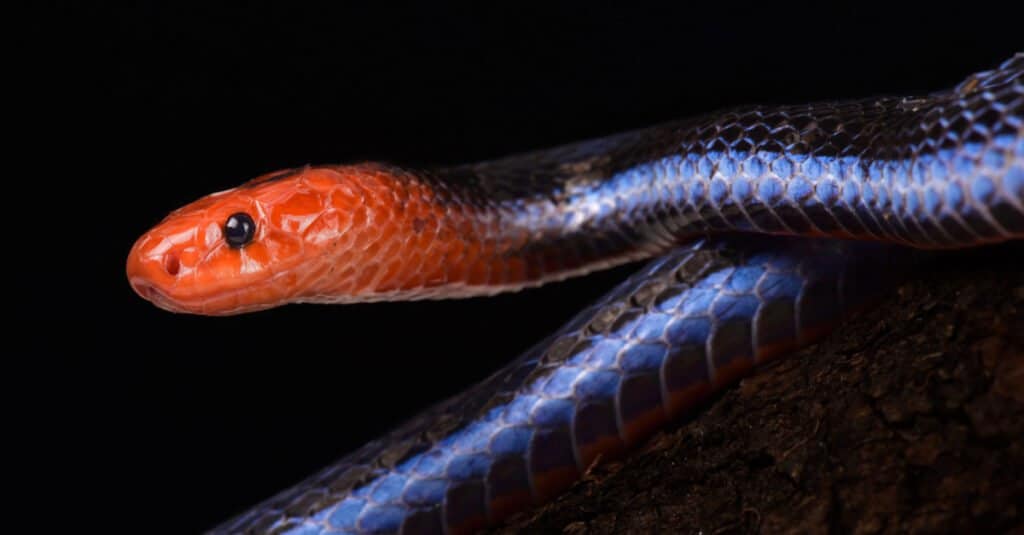
The blue Malaysian coral snake is blue-black with red on its head and tail.
©reptiles4all/Shutterstock.com
The blue Malaysian coral snake mainly dines on other snakes. While it is obviously found in Malaysia, it also lives in Cambodia, Thailand, Singapore, and Indonesia. This snake is aggressive and makes a horrible choice for snake hobbyists.
This snake lives in mainly forested areas, and its underbelly is almost baby blue. It’s a dangerous snake, though it’s worth noting that its venom works in an unusual way. The bite causes paralysis.
Its red head and tail against the monotone geometric black and white on its body are a striking contrast. The detail of its body with the hint of color at either end of this critter definitely makes it one of the coolest-looking snakes on the planet.
5. Banana Ball Python
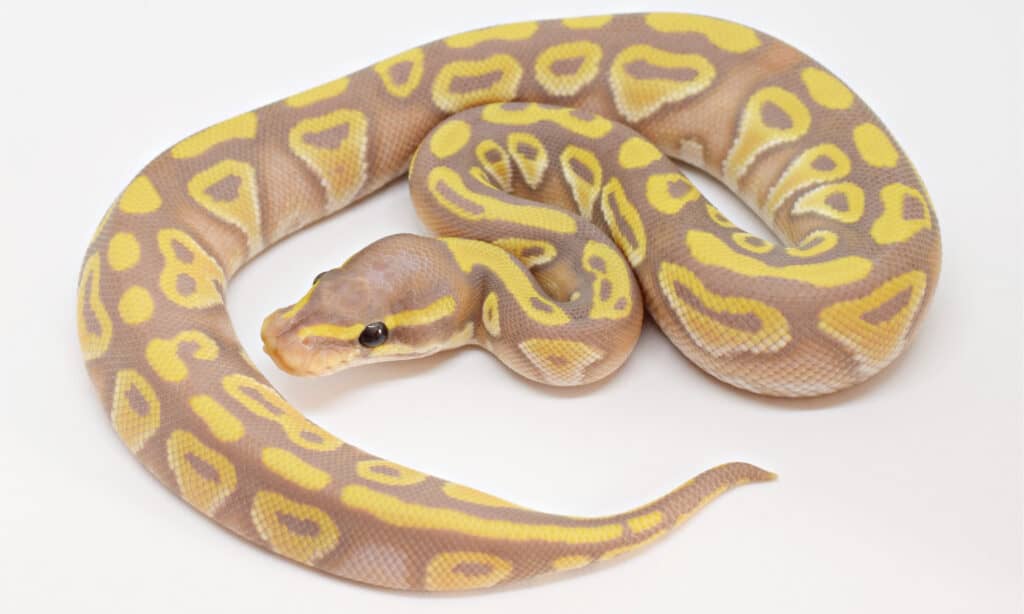
Banana ball pythons have a whimsical pastel coloring.
©pelsopython/Shutterstock.com
Pythons are cool on their own, but the banana ball python is one of the coolest-looking pythons. It is polka-dotted with black spots over a pinkish-cream body with yellow spots.
It’s a very pop-art-looking snake like someone did a fantastic painting by color, and this is the creature that showed up on the page. This snake makes the cool list because its coloration is fabulous.
Ball pythons have the word “ball” in their name because they become curled balls when they get stressed out. These snakes have a good temperament, so they’re popular pet snakes.
4. High Yellow-Green Tree Python
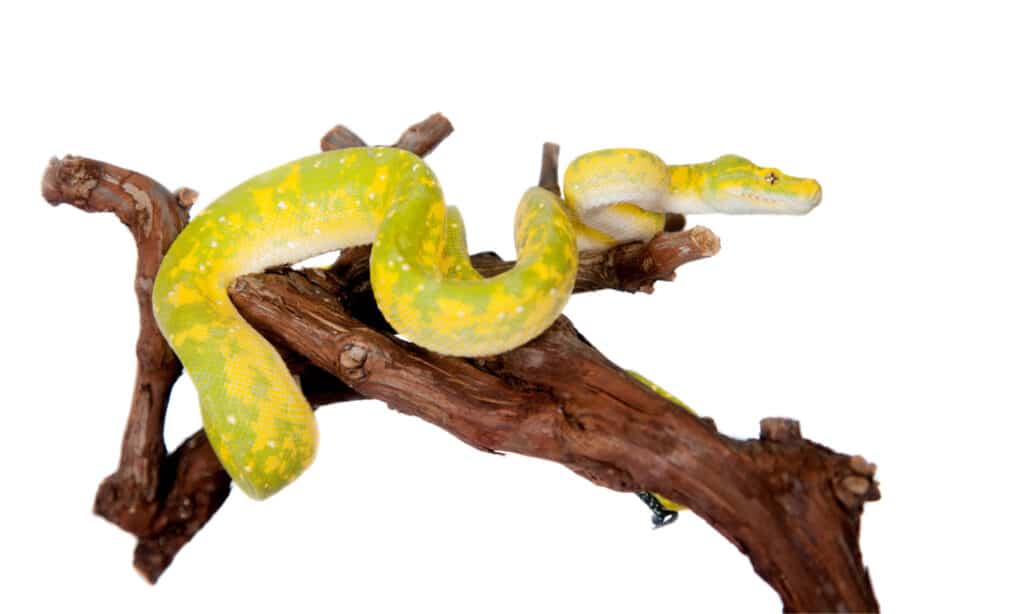
Pixelated high yellow-green tree pythons grow to be almost 7 feet long.
©Rosa Jay/Shutterstock.com
This beauty is a nonvenomous python that can grow up to 7 feet long. It strikes at its prey and constricts it. It mainly lives off mammals, though it will eat lizards and other reptiles. This snake is found on some islands in Indonesia.
The high yellow-green tree python’s vibrant yellow color has an almost pixelated green pattern over the top of it. Both colors are bold and contrast against each other in a way that’s super pleasing to the eye.
3. Brazilian Rainbow Boa
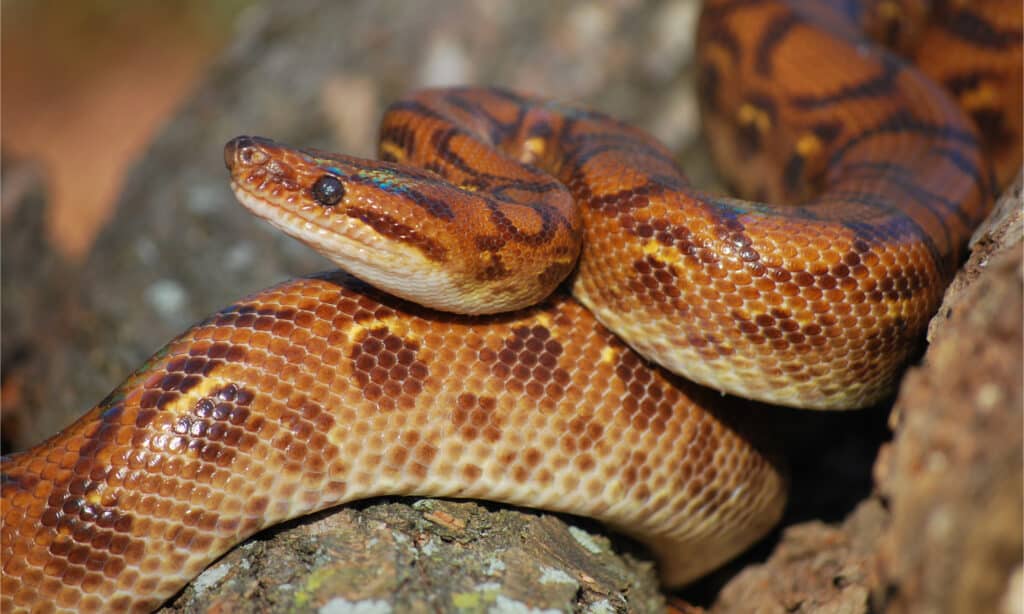
With an oil-slick coloration over its more common patterning, the Brazilian rainbow boa stands out from the crowd.
©Kassia Marie Ott/Shutterstock.com
This is another dazzling snake that has the looks to make it to the coolest-looking snake list. While its iridescence can be found on some other snakes, this one looks the coolest of them all. Its shimmery scales are most glorious right after it sheds.
The reason this snake looks like a colorful oil slick is that there are ridges on its scales that act like little prisms. This prettiness extends for 5 to 7 feet on this larger snake. Its normal coloration is also distinct, so this snake is all-around attractive whether it’s in the sun or not.
These snakes spend half of their time in trees and live in South and Central America, with most being in the Amazon basin. They’re a popular pet with snake connoisseurs, but only intermediate and advanced keepers should give these beauties a shot.
The offspring of these snakes are shy and prone to nipping, but they acclimate to being handled with a little patience. They primarily eat rats and mice when in captivity.
2. Snow Hognose Snake
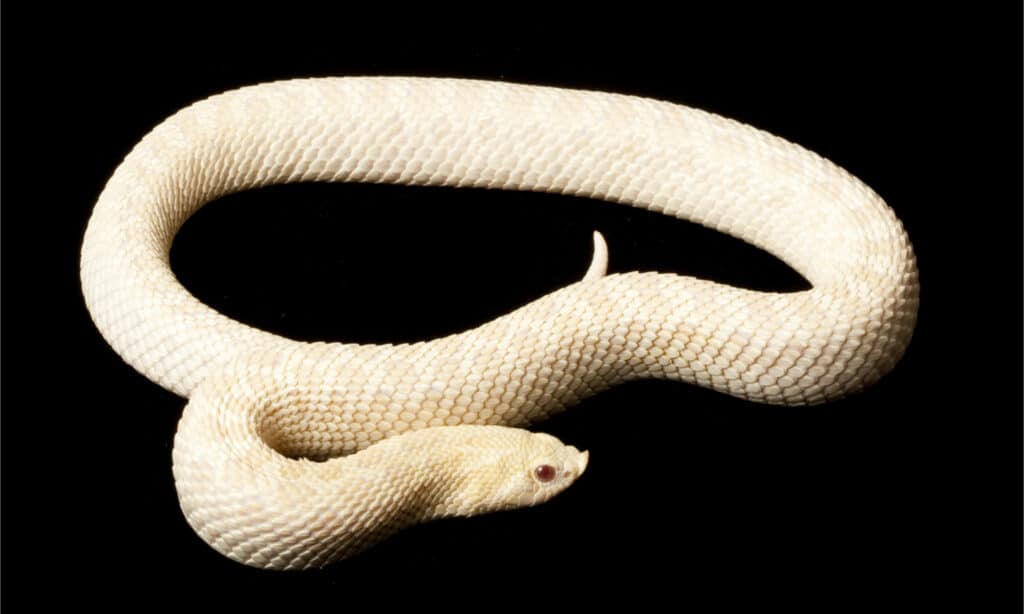
There are many variations of the
hognose snake
, including the snow hognose snake, that’s almost all white.
©fivespots/Shutterstock.com
The snow hognose snake is immaculately white, with some very subtle grey-to-brown differentiations in its patterning. It’ll make a meal out of a variety of species such as small mammals, lizards, insects, worms, salamanders, and birds.
These snakes make themselves puffy when they fear being attacked, but they make great pets because they almost always don’t bite. They are a little venomous, but their fangs are tiny, and venom production is low.
Snow hognose snakes grow up to 3 feet in length. Lots of captive-bred snow hognose snakes are kept as pets not only for their snow-white coloration but for their distinctly flat nose. These snakes are great for first-time snake owners because they have a good temperament and come with little fuss regarding care.
Their nose and coloration are two super cool-looking attributes in one reptile.
1. Paradise Tree Snake
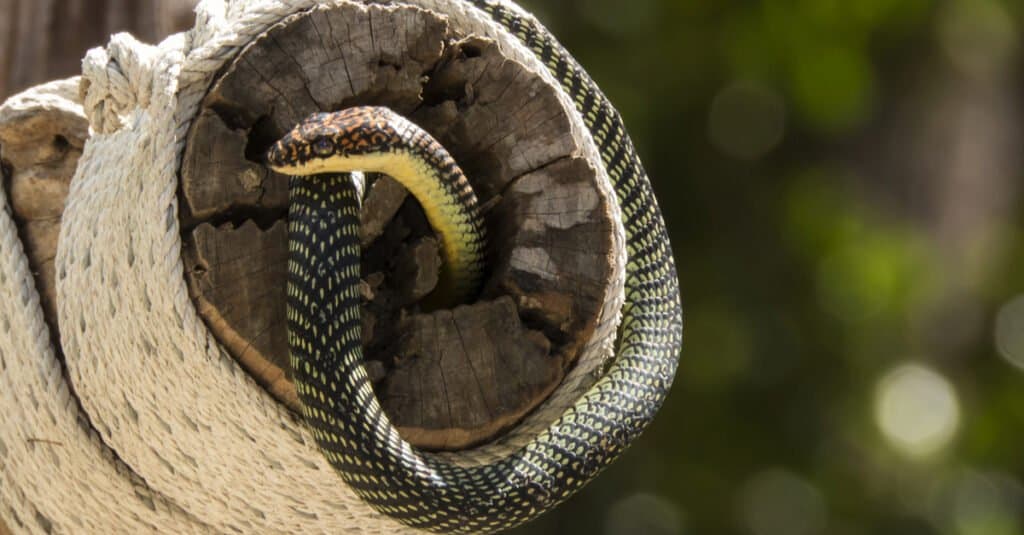
The paradise tree snake is a flying snake and can glide up to 30 feet in the air.
©PACO COMO/Shutterstock.com
The top coolest-looking snake in the world is the paradise tree snake. This snake is one of the numerous flying snakes found on the planet. The paradise tree snake can glide up to 30 feet in the air by flattening its body and undulating to glide.
Found in southeast Asian forests, paradise tree snakes eat mostly lizards and bats. These snakes are black with different color spots, and the brightness of the spots is eye-popping. It’s so cool that something like this can appear in nature when it almost looks like an artist created it.
Top Five Facts About Snakes
Snakes are a diverse group of reptiles that can be found in almost every part of the world. They are known for their long, slender bodies, flexible movements, and sharp fangs.
Here are the top five facts about snakes:
- Variety of species: There are over 3,000 species of snakes, ranging in size from the tiny thread snake, which can be as short as 4 inches, to the giant anaconda, which can grow up to 33 feet long.
- Venomous vs Non-Venomous: Although all snakes have fangs, only about one-third of snake species are venomous. Venomous snakes use their fangs to kill prey, while non-venomous snakes rely on constriction to suffocate their prey.
- No Legs: Snakes are legless, but they are still able to move efficiently by using their muscles to slither along the ground. Some species are also able to climb trees and swim.
- Hinged Jaws: Snakes have hinged jaws that can open wide, allowing them to consume prey much larger than their own heads.
- Sense of Smell: Snakes have a keen sense of smell, which they use to locate prey, mate, and avoid predators.
Finally, snakes are fascinating creatures that have adapted to a wide range of environments and play important roles in their ecosystems as predators and prey. Whether you love them or fear them, there is no denying the incredible diversity and adaptations that make snakes a truly unique group of animals.
Next Up…
The photo featured at the top of this post is © reptiles4all/Shutterstock.com
Discover the "Monster" Snake 5X Bigger than an Anaconda
Every day A-Z Animals sends out some of the most incredible facts in the world from our free newsletter. Want to discover the 10 most beautiful snakes in the world, a "snake island" where you're never more than 3 feet from danger, or a "monster" snake 5X larger than an anaconda? Then sign up right now and you'll start receiving our daily newsletter absolutely free.
Thank you for reading! Have some feedback for us? Contact the AZ Animals editorial team.






